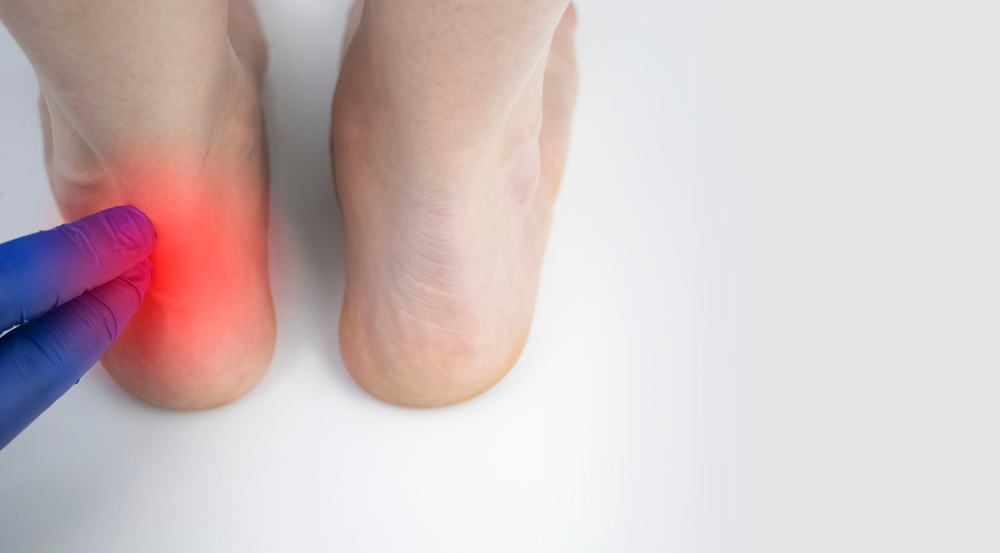Feet-Relief is supported by our audience. When you purchase through one of our links, we may earn a small affiliate commission. As an Amazon Associate I earn from qualifying purchases.Your cost is not affected.
Imagine waking up one day and feeling a sharp pain in your foot or ankle, accompanied by numbness, tingling, or burning sensations. You may think you have injured yourself somehow, but the truth is, you may be suffering from a nerve disorder called tarsal tunnel syndrome. Tarsal tunnel syndrome occurs when the tibial nerve, which runs through a narrow passage in the ankle called the tarsal tunnel, is compressed or damaged by various factors. This causes symptoms such as pain, numbness, tingling, or burning in the foot or ankle, especially along the inner side of the foot. In this article, we explore the causes, symptoms, diagnosis, prevention, and treatment of tarsal tunnel syndrome. Learn how you can cope with this condition.
Introduction to Tarsal Tunnel Syndrome
Tarsal Tunnel Syndrome (TTS) is a medical condition that is relatively unknown to many. Yet it impacts a significant number of individuals. This condition is often misdiagnosed, leading to a delay in proper treatment and prolonging discomfort for patients. But what exactly is Tarsal Tunnel Syndrome?
What is Tarsal Tunnel Syndrome?
Tarsal Tunnel Syndrome involves a nerve entrapment disorder that affects the posterior tibial nerve. This nerve travels down the leg, through the tarsal tunnel, a narrow passageway inside your ankle, and continues into the foot. When this nerve is compressed or squeezed, it often leads to the symptoms that define TTS.
Is it Tarsal tunnel syndrome?
The syndrome is often characterized by pain, numbness, and tingling sensations in the foot.
Understanding what Tarsal Tunnel Syndrome is provides crucial help. In fact, it allows us to explore its causes, symptoms, and potential treatment options. The more we know about TTS, the better we can manage it and reduce its impact on our lives.
Causes of Tarsal Tunnel Syndrome
What causes Tarsal Tunnel Syndrome? The syndrome can result from a variety of factors. This can include anything that puts pressure on the posterior tibial nerve, such as swelling from an injury, arthritis, flat feet, or even systemic diseases like diabetes.
Some of the possible causes of tarsal tunnel syndrome are:
- Flat feet or high arches, which can stretch or compress the tibial nerve.
- Benign tumors, cysts, bone spurs, or varicose veins, which can occupy space and press on the tibial nerve.
- Inflammation of the tendon sheath, nerve ganglions, or arthritis, which can cause swelling and irritation of the tibial nerve.
- Injuries or trauma, such as ankle sprains or fractures, which can cause inflammation and swelling of the surrounding tissues.
- Systemic conditions, such as diabetes or hypothyroidism, which can make the nerve more vulnerable to compression.
It affects people of all ages and may worsen with physical activity. If you have any of these symptoms, you should see a doctor for diagnosis and treatment.
In some cases, the exact cause of the syndrome might not be identifiable, making it even more challenging to manage.
Tarsal Tunnel Syndrome vs Plantar Fasciitis:
Understanding the Difference
Tarsal Tunnel Syndrome is often confused with another common foot pain condition known as Plantar Fasciitis. Although both conditions cause foot pain, the source of the pain and the treatment methods differ significantly.
While TTS is a nerve entrapment disorder, Plantar Fasciitis is primarily an inflammation of the plantar fascia, the thick band of tissue that runs across the bottom of your foot. The pain in Plantar Fasciitis is usually felt in the heel, whereas TTS can cause discomfort anywhere along the tibial nerve.
Location and Cause
The difference between tarsal tunnel syndrome and plantar fasciitis is mainly in the cause and location of the pain.
- Tarsal tunnel syndrome is a nerve disorder that occurs when the tibial nerve, which runs through a narrow passage in the ankle called the tarsal tunnel, is compressed or damaged by various factors.
- Plantar fasciitis is an inflammation of the plantar fascia. This thick ligament connects the heel to the toes and supports the arch of the foot.
- Tarsal tunnel syndrome usually causes numbness, tingling, burning, or pain on the bottom of the foot, especially along the inner side of the foot. The pain may radiate up to the calf and worsen with physical activity or pressure on the foot.
- Plantar fasciitis usually causes pain on the bottom of the heel, near the front, that is worse in the morning or after long periods of standing or walking. The pain may feel like a sharp stab or a dull ache.
- Tarsal tunnel syndrome can be caused by anything that narrows the space of the tarsal tunnel, such as bone spurs, cysts, tumors, inflammation, injury, or foot deformities.
- Plantar fasciitis can be caused by anything that strains or tears the plantar fascia, such as overuse, trauma, poor foot alignment, or shoes that don’t fit well.
- Both conditions affect people of all ages, but some factors may increase the risk, such as being overweight, having flat feet or high arches, having diabetes or hypothyroidism, or wearing high heels.
Diagnose tarsal tunnel syndrome
Tarsal tunnel syndrome and plantar fasciitis can be diagnosed by a doctor based on the symptoms, medical history, and physical examination of the foot and ankle. Sometimes, imaging tests or nerve conduction studies may be needed to confirm the diagnosis or rule out other causes. Scroll down for more details.
Treat tarsal tunnel syndrome
Treatment options may vary depending on the severity and cause of the condition, but they may include rest, ice, anti-inflammatory medications, steroid injections, orthotics, splints, physical therapy, or surgery. Scroll down for more details.
Symptoms of Tarsal Tunnel Syndrome
The symptoms of TTS can vary from person to person, but they often include tingling, burning sensations, numbness, and pain along the inside of the foot and ankle, and sometimes the toes.
These symptoms are typically aggravated by physical activities such as walking or standing for prolonged periods. It is important to pay attention to these signs and seek medical advice if they persist.
Diagnosing Tarsal Tunnel Syndrome:
The Tarsal Tunnel Syndrome Test
Diagnosing TTS can be a challenging process, as its symptoms can mimic those of other conditions. The Tarsal Tunnel Syndrome Test, also known as the Tinel’s sign test, is commonly used to diagnose this condition.
During this test, your doctor will tap over the tibial nerve to see if it produces tingling sensations or discomfort. An MRI or nerve conduction study may also be ordered to confirm the diagnosis.
Conservative Treatments for Tarsal Tunnel Syndrome
Once TTS is diagnosed, the next step is to explore tarsal tunnel syndrome treatments. Conservative treatments are usually the first line of defense against TTS. These can include over-the-counter pain relievers, corticosteroid injections, or the use of custom orthotics to relieve pressure on the nerve.
While these treatments can be effective, it is essential to remember that they are intended to manage the symptoms of TTS and not necessarily eliminate the underlying cause.
Exercises and Stretches for Tarsal Tunnel Syndrome
Alongside conservative treatments, exercises for Tarsal Tunnel Syndrome and tarsal tunnel syndrome stretches can also help manage the symptoms. These exercises and stretches can help strengthen the foot and ankle muscles, improve flexibility, and promote better foot mechanics, which can ultimately reduce nerve compression.
Exercises and stretches for tarsal tunnel syndrome help reduce pain, swelling, and nerve compression in the ankle and foot.
Some of the exercises and stretches that may be beneficial for tarsal tunnel syndrome are:
Calf stretches:
These can help loosen the muscles around the ankle and relieve pressure on the tibial nerve.
To do a calf stretch, stand facing a wall and place your palms flat against it. Step your affected leg behind you and keep it straight. Bend your front knee and lean forward until you feel a stretch in the back of your lower leg. Hold for 20 seconds and repeat three to five times a day.
Posterior tibialis heel lifts:
These can help strengthen the posterior tibialis tendon, which is part of the tarsal tunnel.
To do a posterior tibialis heel lift, stand in front of a chair or counter and place your hands on it for support. Slowly rise up onto your toes and hold for five seconds. Then lower your heels to the ground and repeat 15 times. Do two sets a day.
Plantar fascia stretch:
This can help stretch the plantar fascia, which is a band of tissue under the sole of the foot that connects to the tarsal tunnel.
To do a plantar fascia stretch, sit on the floor with your legs straight and wrap a towel or a band around the ball of your foot. Pull your toes toward you until you feel a stretch in your heel and calf. Hold for 20 seconds and repeat three to five times a day.
Nerve gliding exercises:
These can help improve the mobility and function of the tibial nerve.
To do a nerve gliding exercise, sit on a chair and cross your affected leg over your other leg. Point your toes down and inward and then up and outward. Repeat this motion 10 times and do it several times a day.
These are some examples of exercises and stretches for tarsal tunnel syndrome. Consult your doctor or physical therapist before starting any exercise program and stop if you feel any pain or discomfort. You should also follow their instructions on how to perform the exercises correctly and safely.
Tarsal Tunnel Syndrome Shoes:
How the Right Footwear Can Help
The right footwear can play a pivotal role in managing TTS. Tarsal Tunnel Syndrome shoes should provide good arch support, ample cushioning, and enough room for your toes to move freely. Shoes that are too tight or don’t offer enough support can compress the tibial nerve and exacerbate the symptoms of TTS.
Tarsal tunnel syndrome causes pain, numbness, tingling, or burning in the foot or ankle due to compression or damage of the tibial nerve. The tibial nerve runs through a narrow passage in the ankle called the tarsal tunnel, which can be narrowed or inflamed by various factors, such as foot deformities, injuries, tumors, or systemic diseases.
The right footwear helps relieve the symptoms and prevent the worsening of tarsal tunnel syndrome by providing adequate support, cushioning, stability, and flexibility for the foot and ankle. Some of the features to look for in shoes for tarsal tunnel syndrome are:
Good arch support:
Shoes with good arch support help prevent overpronation, which is when the foot rolls inward excessively and puts pressure on the tibial nerve. Arch support also helps maintain the shape and alignment of the tarsal tunnel and reduce the risk of nerve compression.
Cushioning:
Shoes with cushioning help absorb shock and reduce stress on the foot and ankle, especially on hard or uneven surfaces2. Cushioning also helps prevent friction and irritation of the tibial nerve and the surrounding tissues.
Sturdy heel counter:
Shoes with a sturdy heel counter help stabilize the heel and prevent it from rocking side to side, which can cause nerve compression or damage. A heel counter is the back part of the shoe that wraps around the heel and provides support and structure.
Extra depth:
Shoes with extra depth help accommodate swelling, inflammation, or orthotic devices that may be needed for tarsal tunnel syndrome. Extra depth also helps prevent tightness or pressure on the foot and ankle, which can worsen the symptoms.
Firm midsole and outer sole:
Shoes with a firm midsole and outer sole can help provide a solid base and prevent excessive bending or twisting of the foot and ankle, which can aggravate the tibial nerve.
A midsole is the layer between the insole and the outer sole that provides cushioning and support. An outer sole is the bottom part of the shoe that contacts the ground and provides traction and durability.
Some examples of shoes that have these features and are recommended for tarsal tunnel syndrome are:
Orthofeet Shoes:
Orthofeet shoes have features that can help reduce the pressure and irritation on the tibial nerve, which runs through the tarsal tunnel in the ankle and causes the condition. Some of these features are:
- Good arch support:
Orthofeet shoes have orthotic insoles that provide anatomical arch support, which can help prevent overpronation, a common cause of tarsal tunnel syndrome. Overpronation is when the foot rolls inward excessively and puts strain on the tibial nerve.
-
Cushioning:
Orthofeet shoes have a patented spring system that provides shock absorption and energy return, as well as heel cushioning, which can help reduce the impact and stress on the foot and ankle. Cushioning can also help prevent friction and inflammation of the tibial nerve and the surrounding tissues.
- Sturdy heel counter:
Orthofeet shoes have a firm and cushioned heel counter, which can help stabilize the heel and prevent it from rocking side to side, which can cause nerve compression or damage. A heel counter is the back part of the shoe that wraps around the heel and provides support and structure.
- Extra depth:
Orthofeet shoes have extra depth, which can help accommodate swelling, inflammation, or orthotic devices that may be needed for tarsal tunnel syndrome. Extra depth can also help prevent tightness or pressure on the foot and ankle, which can worsen the symptoms.
- Firm midsole and outer sole:
Orthofeet shoes have a firm midsole and outer sole, which can help provide a solid base and prevent excessive bending or twisting of the foot and ankle, which can aggravate the tibial nerve. A midsole is the layer between the insole and the outer sole that provides cushioning and support. An outer sole is the bottom part of the shoe that contacts the ground and provides traction and durability.
These are some of the reasons why Orthofeet shoes are good for tarsal tunnel syndrome. They are designed to provide comfort, support, and relief for people who suffer from this condition. You can find more information about Orthofeet shoes and their benefits on their website.
Other Shoes to consider for Tarsal tunnel syndrome include:
These shoes have a patented spring system that provides shock absorption and energy return, as well as orthotic insoles that provide arch support and heel cushioning. They also have a roomy toe box and a breathable mesh upper that offer comfort and flexibility.
These sneakers have a podiatrist-designed footbed that provides arch support and heel stability, as well as a durable rubber outsole that provides traction and flexibility. They also have a lightweight and breathable mesh upper that offers a snug and comfortable fit.
ASICS GEL-Venture 5 Running Shoe:
These running shoes have a gel cushioning system that reduces impact and a removable sockliner that accommodates orthotics. They also have a trail-specific outsole that provides grip and stability on various terrains and a synthetic and mesh upper that provides breathability and durability.
Shoes for Tarsal Tunnel
These are some of the shoes that can help with tarsal tunnel syndrome, but you should always consult your doctor or podiatrist before choosing any footwear and follow their advice on how to wear and care for them.
Role of Physical Therapy in Tarsal Tunnel Syndrome Treatment
Physical therapy provides a key component of Tarsal Tunnel Syndrome treatment. Physical therapists can provide a tailored exercise and stretching program to address your specific needs. They also provide education on how to modify your activities and choose the right footwear to minimize symptoms.
Tarsal Tunnel Syndrome Brace and Medical Devices
In addition to physical therapy and the right footwear, a Tarsal Tunnel Syndrome brace or other medical devices helps manage TTS. A brace provides additional support to the foot and ankle and helps reduce pressure on the tibial nerve.
Other devices, like custom orthotics, also help redistribute weight and pressure more evenly across your foot, alleviating symptoms.
Tarsal Tunnel Syndrome Surgery: When is it Necessary?
In some cases, when conservative treatments fail to relieve symptoms, Tarsal Tunnel Syndrome surgery may be considered. This surgery generally involves releasing the ligament that forms the roof of the tarsal tunnel to reduce pressure on the tibial nerve.
Tarsal tunnel syndrome surgery aims to relieve the pressure on the tibial nerve, which runs through a narrow passage in the ankle called the tarsal tunnel. The surgery involves making an incision from behind the ankle down to the arch of the foot and releasing the ligament that forms the roof of the tarsal tunnel. This allows the nerve to have more space and reduces the symptoms of pain, numbness, tingling, or burning in the foot or ankle.
Some of the nonsurgical treatments that may be tried first include:
- Resting the foot and avoiding activities that worsen the symptoms.
- Taking anti-inflammatory medications or steroid injections to reduce pain and swelling.
- Wearing braces, splints, or orthotic devices to support the foot and limit movement that could cause nerve compression.
- Doing physical therapy exercises and stretches to improve the mobility and function of the nerve.
Tarsal tunnel syndrome surgery may be necessary when:
- The symptoms are severe, persistent, or interfere with daily activities.
- The nerve damage is progressive or irreversible.
- The nerve compression is caused by a tumor, cyst, bone spur, or other growth that cannot be removed by other means.
- The nerve compression is caused by a systemic condition, such as diabetes or hypothyroidism, that cannot be controlled by medication.
Tarsal tunnel syndrome surgery is generally a safe and effective procedure, but it may have some risks and complications, such as:
- Infection, bleeding, or nerve injury.
- Recurrence of symptoms or incomplete relief.
- Scar tissue formation or stiffness of the ankle.
- Complex regional pain syndrome, a rare condition that causes chronic pain and swelling in the affected limb.
If you have tarsal tunnel syndrome and are considering surgery, consult your doctor or podiatrist for a proper diagnosis and treatment plan. They evaluate your condition and recommend the best option for you based on your symptoms, medical history, and physical examination. They also explain the benefits and risks of the surgery and answer any questions you may have.
While surgery can offer relief, it is important to remember that as with any surgical procedure, there are risks involved, and it is typically viewed as a last resort.
Managing Tarsal Tunnel Syndrome
Understanding Tarsal Tunnel Syndrome, its causes, symptoms, and treatments helps you manage this condition more effectively. While TTS can be a challenging condition to live with, it is important to remember that with the right approach, it can be managed successfully.
If you suspect TTS, seek medical advice to get the right diagnosis and treatment plan. Early diagnosis and early treatment help reduce severe symptoms, decrease pain, and prevent permanent nerve damage
Remember, Tarsal Tunnel Syndrome doesn’t have to control your life.
With the right knowledge and resources, you take control of your TTS and get back to living a pain-free life. Early treatment may prevent permanent nerve damage.
Amazon and the Amazon logo are trademarks of Amazon.com, Inc, or its affiliates.







